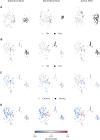Multitask Learning for Activity Detection in Neovascular Age-Related Macular Degeneration
- PMID: 37052912
- PMCID: PMC10103736
- DOI: 10.1167/tvst.12.4.12
Multitask Learning for Activity Detection in Neovascular Age-Related Macular Degeneration
Abstract
Purpose: The purpose of this study was to provide a comparison of performance and explainability of a multitask convolutional deep neuronal network to single-task networks for activity detection in neovascular age-related macular degeneration (nAMD).
Methods: From 70 patients (46 women and 24 men) who attended the University Eye Hospital Tübingen, 3762 optical coherence tomography B-scans (right eye = 2011 and left eye = 1751) were acquired with Heidelberg Spectralis, Heidelberg, Germany. B-scans were graded by a retina specialist and an ophthalmology resident, and then used to develop a multitask deep learning model to predict disease activity in neovascular age-related macular degeneration along with the presence of sub- and intraretinal fluid. We used performance metrics for comparison to single-task networks and visualized the deep neural network (DNN)-based decision with t-distributed stochastic neighbor embedding and clinically validated saliency mapping techniques.
Results: The multitask model surpassed single-task networks in accuracy for activity detection (94.2% vs. 91.2%). The area under the curve of the receiver operating curve was 0.984 for the multitask model versus 0.974 for the single-task model. Furthermore, compared to single-task networks, visualizations via t-distributed stochastic neighbor embedding and saliency maps highlighted that multitask networks' decisions for activity detection in neovascular age-related macular degeneration were highly consistent with the presence of both sub- and intraretinal fluid.
Conclusions: Multitask learning increases the performance of neuronal networks for predicting disease activity, while providing clinicians with an easily accessible decision control, which resembles human reasoning.
Translational relevance: By improving nAMD activity detection performance and transparency of automated decisions, multitask DNNs can support the translation of machine learning research into clinical decision support systems for nAMD activity detection.
Conflict of interest statement
Disclosure:
Figures







References
-
- World Health Organization, ed. World report on vision. Available at: https://www.who.int/publications/i/item/9789241516570.
-
- Wong WL, Su X, Li X, et al. .. Global prevalence of age-related macular degeneration and disease burden projection for 2020 and 2040: a systematic review and meta-analysis. Lancet Glob Health. 2014; 2(2): e106–e116. - PubMed
-
- Ferris FL III, Fine SL, Hyman L. Age-Related macular degeneration and blindness due to neovascular maculopathy. Arch Ophthalmol. 1984; 102(11): 1640–1642. - PubMed
Publication types
MeSH terms
LinkOut - more resources
Full Text Sources
Medical

